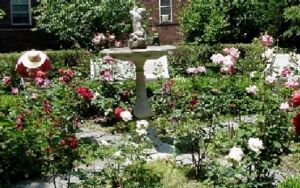From The Peopling of New York City

~ G A L L E R Y ~E N V I R O N M E N T~H I S T O R Y~ E C O N O M Y~C U L T U R E~D E M O G R A P H I C S
Location
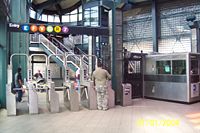
Many trains stop at Jackson Heights.
A bustling neighborhood in the North Western border of Queens, (the largest of
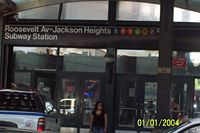
The Train Station at Roosevelt Avenue
the five boroughs of New York City), Jackson Heights has Northern Boulevard to the north, the Brooklyn-Queens Expressway to the west, Roosevelt Avenue to the south, and Junction Boulevard to the east. East Elmhurst, the area immediately to the north, from Northern Boulevard (formally known as Jackson Avenue and was eventually responsible for the naming of the area as Jackson Heights) up to the Grand Central Parkway, is sometimes regarded as a northward extension of the neighborhood. Jackson Heights is surrounded by other neighborhoods in Queens including Elmhurst, Woodside, Astoria and East Elmhurst. Its location just across the east river gives commuters easy access to the city.
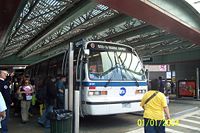
Roosevelt Avenue Bus Terminal.
Jackson Heights is a 20-minute commute on the 7-subway train to Midtown Manhattan from the 82nd Street station. You can also take the E, F, G, R, or V trains from Roosevelt Avenue. This makes Jackson Heights a very accessible neighborhood to its residents and visitors. It is also one of New York City’s busiest train station stops. The Q33 bus goes to LaGuardia Airport's main terminals and operates 24 hours a day. The Q47 bus goes to the Marine Air Terminal. The Long Island Rail Road Woodside station is nearby on 61st Street and Roosevelt Avenue, which are two stops on 7 trains. From Roosevelt Avenue you gain access to Manhattan, Brooklyn, Long Island, La Guardia and many other places.
Garden City Apartments

The Garden City Apartments founded by Edward MacDougall in the 1920s.
Although Jackson Heights is considered a commercialized area, it is also known for its residential district. A residential co-op that provides a private garden for its residents is Garden City Apartments. Founded by Edward MacDougall, the Garden
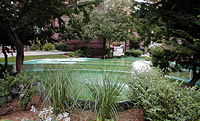
A fountain shared by the residents.
City Apartments was the first garden community created in the United States based on the ideas of the Garden City Movement in England. The purpose of this architectural housing style was to bring people from crowded urban centers to towns that had open space, sunlight and fresh air, because of the belief that including green areas and ventilation in residential districts was healthier for the people. They also wanted to lure upper middle class residents from Manhattan to a less congested paradise.
- The apartment buildings would be built to surround an interior communal
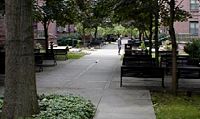
A communal garden with benches for the residents.
garden that all the residents could share and enjoy. This garden was created for landscape reasons, as well as a private place for residents to socialize, relax, play and gather together. As a residential co-op, all of the residents work together to take care of the interior gardens. At times, many residents would gather to plant flowers and garden. Only about 40% of the land was built for the residential buildings, which were five stories high, and the other 60% was kept to develop the gardens. Jackson Height’s was deemed as a city within in a city because the community including both residential and commercial buildings, making the neighborhood an easy access for its residents.
[4]
- The individual apartment buildings of MacDougall's fifteen garden apartment blocks, were typically U-shaped and were separated or connected to each other, depending on the architect. Two architects, George H. Wells and Andrew J. Thomas, designed most of the apartments for MacDougall. Thomas' apartments were physically separated from each other and contained two apartments per floor, an apartment typically being three rooms deep and two rooms wide with a small hall separating it from the other apartment on the same floor.
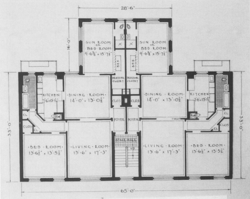
Blue Prints of a Garden City Apartment.
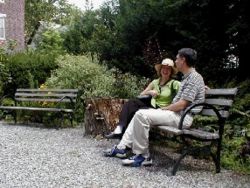
A couple sitting on a bench in the interior garden.
The Jackson Heights Beautification Group (JHBG) is a community organization of people who live and work in Jackson Heights and care about making Jackson Heights one of the best neighborhoods not only in Queens, but also in New York City. JHBG is a nonprofit organization that aims to make Jackson Heights safe and diverse for its residents. They are in favor of keeping the neighborhood clean, having greenery planted and keeping schools and other institutions preserved. However, they are against crime, littering, intolerance and noise. The JHBG puts together events such as planting flowers and trees, having a Halloween Parade for kids, clean streets, and having free concerts in Parks.
[7]

A fountain shared by the residents.
Another community organization is the Western Jackson Heights Alliance where residents work together to make living qualities better in the neighborhood. It was formed to ensure safe and livable conditions in the neighborhood. Some of their goals are to keep streets clean, expand and protect green land, and reduce noise and congestion. Their plans of action are to participate in improving the appearance of their neighborhood, address and inform residents about the issues, and have more enforcement around the residential areas. Some methods that alliance has taken to improve the neighborhood have been to increase the number of hybrid buses that service in Jackson Heights. They have also filed complaints about the pollution in the air, the constant noise of car horns, the dangerous intersections, and the dirty streets that affect their neighborhood.
[9]
Many of these community centers and organizations have formed a site where the neighborhood can post news up for the residents. It is called Jackson Heights Neighborhood News and has details about upcoming events in Jackson Heights. [10]
~ G A L L E R Y ~E N V I R O N M E N T~H I S T O R Y~ E C O N O M Y~C U L T U R E~D E M O G R A P H I C S
References
- ↑ http://www.communitygreens.org/ExistingGreens/jacksonheights/jacksonheights.htm
- ↑ http://www.communitygreens.org/ExistingGreens/jacksonheights/jacksonheights.htm
- ↑ http://www.communitygreens.org/ExistingGreens/jacksonheights/jacksonheights.htm
- ↑ http://www.communitygreens.org/ExistingGreens/jacksonheights/jacksonheights.htm
- ↑ http://www.communitygreens.org/ExistingGreens/jacksonheights/jacksonheights.htm
- ↑ http://www.communitygreens.org/ExistingGreens/jacksonheights/jacksonheights.htm
- ↑ http://www.jhbg.org/
- ↑ http://www.communitygreens.org/ExistingGreens/jacksonheights/jacksonheights.htm
- ↑ http://www.wjha.org/
- ↑ http://jacksonheightsnyc.blogspot.com/2007/09/jackson-heights-film-food-festival.html








